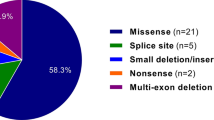Abstract
With significant advances in genomic technologies over recent years, Next-generation sequencing (NGS) has become an important tool not only for gene discovery and research but also for clinical genetic diagnosis of rare disorders and single-gene-disorder analysis. Many hundreds of single-gene disorders have been described that can manifest prenatally and will comprise a large portion of undiagnosed, chromosomally normal cases but underlying cause of the abnormality still remains unknown for the large majority of cases with an abnormal ultrasound. However, there has been little experience and study in using trio whole exome sequencing (WES) for prenatal diagnosis. In this report the NGS method was applied for the prenatal genetic diagnosis of unidentified life-threatening phenotype in one family and confirmed the pattern of inheritance of titinopathy as well as two novel TTNgene variations. The report presented in these pages offers a unique and valuable perspective on relevance and feasibility of NGS in prenatal diagnosis field.
Similar content being viewed by others
References
Callaway, J.L., Shaffer, L.G., Chitty, L.S., Rosenfeld, J.A. & Crolla, J.A. The clinical utility of microarray technologies applied to prenatal cytogenetics in the presence of a normal conventional karyotype: a review of the literature. Prenat. Diagn. 33, 1119–1123 (2013).
Chitty, L.S. et al. Non-invasive prenatal diagnosis of achondroplasia and thanatophoric dysplasia: next-generation sequencing allows for a safer, more accurate, and comprehensive approach. Prenat. Diagn. 35, 656–662 (2015).
Hill, M. et al. Non-invasive prenatal diagnosis for cystic fibrosis: detection of paternal mutations, exploration of patient preferences and cost analysis. Prenat. Diagn. 35, 950–958 (2015).
Yang, Y. et al. Clinical whole-exome sequencing for the diagnosis of mendelian disorders. N. Engl. J. Med. 369, 1502–1511 (2013).
Filges, I. & Friedman, J.M. Exome sequencing for gene discovery in lethal fetal disorders-harnessing the value of extreme phenotypes. Prenat. Diagn. 35, 1005–1009 (2015).
Filges, I. et al. Exome sequencing identifies mutations in KIF14 as a novel cause of an autosomal recessive lethal fetal ciliopathy phenotype. Clin. Genet. 86, 220–228 (2014).
Labeit, S., Kolmerer, B. & Linke, W.A. The giant protein titin. Emerging roles in physiology and pathophysiology. Circ. Res. 80, 290–294 (1997).
Opitz, C.A. et al. Damped elastic recoil of the titin spring in myofibrils of human myocardium. Proc. Natl. Acad. Sci. U S A 100, 12688–12693 (2003).
Bang, M.L. et al. The complete gene sequence of titin, expression of an unusual approximately 700-kDa titin isoform, and its interaction with obscurin identify a novel Z-line to I-band linking system. Circ. Res. 89, 1065–1072 (2001).
Itoh-Satoh, M. et al. Titin mutations as the molecular basis for dilated cardiomyopathy. Biochem. Biophys. Res. Commun. 291, 385–393 (2002).
Hackman, P. et al. Tibial muscular dystrophy is a titinopathy caused by mutations in TTN, the gene encoding the giant skeletal-muscle protein titin. Am. J. Hum. Genet. 71, 492–500 (2002).
Author information
Authors and Affiliations
Corresponding author
Rights and permissions
About this article
Cite this article
Shim, S.H., Kim, J.Y., Sung, S.R. et al. Prenatally diagnosed TTN mutation with repeated bilateral club foot by whole exome sequencing. BioChip J 11, 240–245 (2017). https://doi.org/10.1007/s13206-017-1309-6
Received:
Accepted:
Published:
Issue Date:
DOI: https://doi.org/10.1007/s13206-017-1309-6




